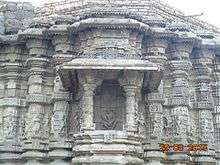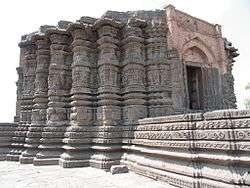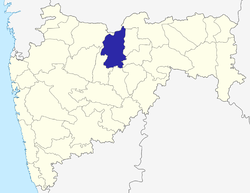Lonar
| Lonar लोणार | |
|---|---|
| city | |
 Lonar Location in Maharashtra, India | |
| Coordinates: 19°59′N 76°31′E / 19.98°N 76.52°ECoordinates: 19°59′N 76°31′E / 19.98°N 76.52°E | |
| Country |
|
| State | Maharashtra |
| District | Buldana |
| Elevation | 563 m (1,847 ft) |
| Population (2001) | |
| • Total | 20,082 |
| Languages | |
| • Official | Marathi |
| Time zone | IST (UTC+5:30) |
Lonar is a town and municipal council in Buldhana district of Vidarbha region of the Indian state of Maharashtra. The town is the headquarter of Lonar taluka and is located near Mehkar.
Lonar is famous for Lonar crater and Lonar Lake, which is located at 19°58′N 76°30′E / 19.967°N 76.500°E. It is a meteorite crater created in the Pleistocene Epoch. The crater contains salt water lake 1.8 km in diameter and about 137 m below the level of the crater rim. A small fresh water stream drains into the lake. Due to evaporite effects, the lake is mineral rich and salty and sodium and potassium salts are extracted from it.


Geography
Lonar is situated around 360 km from Nagpur, around 100 km from Buldhana, around 100 km from Akola, 550 km from Mumbai, around 160 km from Aurangabad and around 140 km southeast of the Ajanta Caves, about 4½ hours drive via Buldhana.[1]
Lonar town is located at 19°59′06″N 76°31′23″E / 19.98500°N 76.52306°E.[2] It has an average elevation of 563 m (1847 feet).
Demographics
As of the 2001 Indian census,[3] Lonar had a population of 20,082. Males constitute 52% of the population and females 48%. Lonar has an average literacy rate of 66%, higher than the national average of 59.5%: male literacy is 74%, and female literacy is 58%. In Lonar, 16% of the population is under 6 years of age.
Temples
Innumerable temples have been built since ancient times around the rim of the crater and further down around the lake.
Daityasudan Temple


One of the most exquisitely built, this temple is on the rim of the bowl of the main crater. One must go inside the narrow lanes of the town to visit this masterpiece. There are many erotic sculptures around this temple. This is a Vishnu temple with Durga, Sun and Nrusimha on the three remaining sides of the temple. The east side is the main entrance. This temple has a base of seven layers of stone platforms. It is not very clear whether the top was left incomplete by the architects or whether it was demolished or damaged by natural causes.
The Daitya Sudan temple is carved in a style similar to Khajurao temples. It has an idol that is composed of a stone-like ore with a high metal content.
Lonardhar Temple

This is a Vishnu temple built on the one foot wide water stream which falls into a "kund" constantly throughout the year. It is the stream which was caused by the impact of the main meteor. It is still not clear how and where the water stream is sourced. The rim is at a much higher altitude than surrounding areas, thereby making it another mystery.
Kamalaja Temple

This is at the south end of the lake. It is dedicated to the Goddess Kamalaja. Every year a festival is held there by the devotees.
Motha Maruti Temple

This is a nine foot long big Hanuman temple, believed to be part of the splinter that might have fallen nearby.
Ambar Lake

This lake was formed by a small stone which might have been separated from the main meteor.
Flora and fauna
Lonar has its own ecological system. As the sun sets, the entire lake appears differently. The lake water sweeps across the shore like sea water, and the birds, wolves, peacocks and other creatures start making their presence felt. It is a wonderful scene to watch the sun rising or setting below the lake walls. The lake has a remarkable presence of splinters of glass confirming the meteorite's impact, which caused the enormous temperature rise thereby turning the sand into glass.
Tourism
The nearest train stations are Shegaon near Khamgaon and Malkapur near Bhusawal railway-junction, on the Mumbai-Bhusawal-Nagpur route of Central Railway of Indian Railways and is around 100 km from Lonar. Buses also run to Lonar from Nagpur, Akola, Buldhana, Malkapur and Jalna.
If travelling from Nagpur, one must take a bus till Mehkar near Washim and then head to Lonar. From Mumbai or Pune, the most convenient route is to first reach Aurangabad via bus (Mumbai and Pune) or train/flight (from Mumbai only) and then take a state transport bus to Lonar. From Pune, air-conditioned and regular buses run every hour from the Shivajinagar bus stand to Aurangabad.
Maharashtra Tourism runs a resort just 50 meters from the lake. This property is modern, well maintained and cheap. There also are several low cost and simple accommodations called lodges available in the town.
The food available in Lonar has influence from both Khandesh and Marathwada cuisines. It is unique and simple but spicy.
Notable features
The Lonar crater is the world's only salt water lake in basaltic rock, believed to have been caused by a meteorite hitting Earth around 52,000 years ago.[4] It is surrounded by forests with a large variety of birds, particularly peacocks, owls, red-wattled lapwings and ducks.
References
- ↑ http://www.theindia.info/travel/lonarcrater.htm
- ↑ Falling Rain Genomics, Inc - Lonar
- ↑ "Census of India 2001: Data from the 2001 Census, including cities, villages and towns (Provisional)". Census Commission of India. Archived from the original on 2004-06-16. Retrieved 2008-11-01.
- ↑ Active methylotrophs in the sediments of Lonar Lake, a saline and alkaline ecosystem formed by meteor impact. The ISME Journal advance online publication, 17 June 2010
 |
Chikhali | Mehkar | Washim |  |
| Sindkhed Raja, Bibi, Sultanpur | |
Risod(Washim district) | ||
| ||||
| | ||||
| Partur,(Jalna district) | Mantha |
